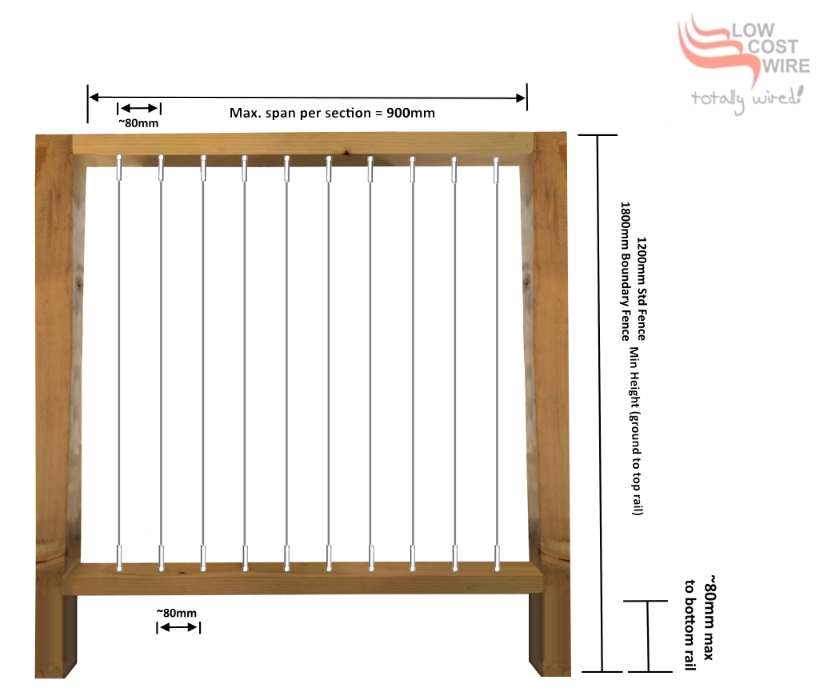Pool Fencing Regulations in Australia
Drowning is the largest cause of preventable deaths. This has led the local governments to focus on pool safety. The best way to ensure that your pool is safe is to install NCC compliant Pool Fencing
Here are some general guidelines for pool fencing regulations in Australia. And please note that this information is provided by Low Cost Wire as a guide and a service and does not constitute a warranty form or interpretation or legal advice
General Pool Fencing Regulations in Australia
There are some general regulations that apply to pool fencing in Australia, and there are some regulations that apply from state to state. These include:

- You should not have any climbable objects such as trees, plants, BBQs, outdoor furniture, pot plants, pool pumps, and so on, within at least 90cm of the pool fence, so that kids cannot use them to help climb over the fence
- Walls can form part of the swimming pool fencing but you must not be able to access the pool directly from the home (in some cases, this is allowed but you must have self closing and self latching doors, and child resistant windows)
- Regulations apply equally to indoor and outdoor pools.
- Pool Fence must
- be constructed from a durable material, be well maintained, and free of any gaps, holes or damage
- be a minimum of 1.2m high when measured from the outside, and any boundary fences that make up the pool fence must be at least 1.8m high
- have a gap of no more than 10cm (8cm recommended)
- between each wire and/or post, and
- between the bottom of the pool fencing and the ground
- The gate must open outwards away from the pool area and it must be fully self closing and self latching, no matter what open position it is in
- The mounting of the latch for the gate
- if on the inside of the gate, you must reach over the gate to open it.
- if it is on the outside of the gate, it must be at least 1.5m high
Pool Fencing Regulations State by State
While the general pool fencing regulations are pretty similar Australia wide, you should be aware that each individual state may have brought in its own regulations that swimming pool owners have to abide by.
Heavy penalties are often imposed for failing builder, your local council, or the relevant government building So before installing a new pool fence or before you build a new pool so that you understand what your requirements are and so that y
ou can ensure that you are meeting your obligations from the get go.
Can I use a wire balustrade solution around a pool?
YES: and you must use a vertical wire solution to both comply with the regulations and to prevent climbing. The technical regulations are a bit different (as above). Then there are some Gate regulations – but it is VERY doable – Just follow the basic guide for a Vertical Wire Solution and you’ll ‘be right’
The Vertical Wire Solution- Special Case Pool Fence: Major difference here is your top rail height. This advice applies to both Timber and Metal rail/post constructions. You will need a top rail and a place on the bottom into which to fasten the fittings. There are many ways to achieve this – but this advice is based on our commercial experience… The top rail needs to be thick enough to accept a 40mm thread. T-Section construction is also recommended for maximum rigidity. For bottom fastening, we recommend a bottom rail (at least 40mm thick) spaced 80mm above the surface. Plan your installation around straight-line sections with 1M centers (~900mm between posts), and plan to fit your wires and posts according to NCC Regulations. And there is a table below for doing horizontal wire balustrades. But the simplest guidelines (for All wire structures…) that work EVERY TIME are:
- Keep your top rail 1.8M high,
- Keep your wires ~80mm apart, and
- Keep your posts ~900mm apart.
This means that a balustrade with wire support posts every 900mm will require 10 runs/kits of wire in each vertical section. When installed at 80mm apart – the prescribed tension/deflection will be easily achieved.